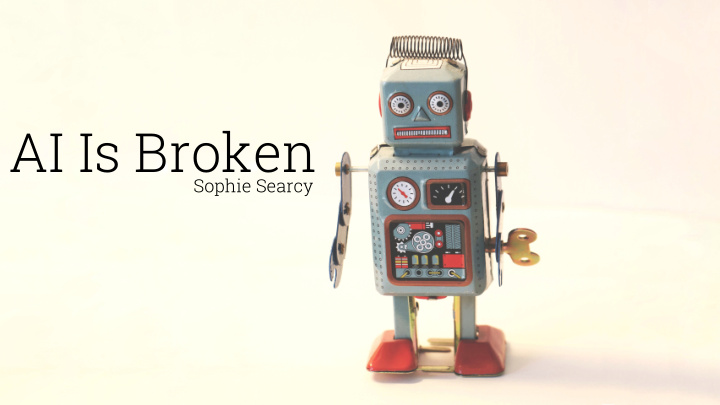



AI Is Broken Sophie Searcy
AI Is Broken slides at soph.info/ai-traps Sophie Searcy
Caveats • AI • lumping together Data Science, Artificial Intelligence, Machine Learning, Data Mining, etc. • Audience • Conversant in AI topics. • Not necessarily experts or practitioners.
What is AI?
Model: a learning algorithm • A model is a small thing that captures a larger thing. • A good model omits unimportant details while retaining what’s important.
Model: a learning algorithm • Industry sometimes uses “algorithm” and “model” interchangeably. • Words are complicated (ask anyone who works in NLP)
Learn verb \’lern\ to process past experience and update a model such that the the model is more useful for future experience
Learn verb \’lern\ to process past experience and update a model such that the the model is useful for future experience
Learn verb \’lern\ to process past experience and update a model such that the the model is useful for future experience
Learn verb \’lern\ to process past experience and update a model such that the the model is useful for future experience
Model: a learning algorithm • All models contain a Input Data prediction function Prediction function Prediction
Model: a learning algorithm • Parameters Input Data • Determine model output • Learned from data Prediction Parameters function Prediction
Model: a learning algorithm
Models are data hungry
Models are data hungry Models • Learn from a limited set of training data • Apply what was learned to production • “Production” is data science lingo for the entire world
Models are data hungry Models • Learn from a limited set of training data • Apply what was learned to production • “Production” is data science lingo for the entire world One of the most difficult tasks in AI: • use training data (data you have) to judge how a model will perform in production (data you don’t have) .
Speed limits for data
Speed limits for data “Traditional” models (Support Vector Machines, Linear Models, Random Forests, K Nearest Neighbors) • Batch data: look at the entire dataset at once. • Training time increases with dataset size.
Speed limits for data Data Set Size Time to train 💿 💿💿 💿💿💿💿
Speed limits for data Data Set Size Time to train 💿 💿💿 💿💿💿💿
Speed limits for data Data Set Size Time to train 💿 💿💿 💿💿💿💿
Eric Drowel et al.
Traditional Approaches Eric Drowel et al.
Modern AI removes the speed limit
Enter Stochastic Gradient Descent • In the last two decades, AI has shifted to approaches that strongly incentivize large datasets • SGD powers Deep Learning models • Traditional AI models have been modified to take advantage of SGD
How does SGD work? Gradient descent ( not stochastic ) 1. Put a number on your model’s performance. (Loss function) 2. Determine which direction decreases the loss function. (Find the Gradient). 3. Turn the knob in that direction. (Backpropagation) (Wash, rinse, repeat for every parameter)
How does SGD work? Stochastic Gradient Descent: • Use a small subset of your dataset to estimate the loss for the entire dataset (Minibatch)
• For SGD-based models, the amount of time it takes to fit a model does not depend on the size of the dataset .
Stochastic Gradient Descent Data Set Size Time to train 💿 💿💿 💿💿💿💿
Stochastic Gradient Descent Data Set Size Time to train 💿 💿💿 💿💿💿💿
Stochastic Gradient Descent Data Set Size Time to train 💿 💿💿 💿💿💿💿
Traditional Approaches SGD Eric Drowel et al.
slide: Andrej Karpathy; photo: Lisha Li
Scale is bad
Scale is bad AI models either • Replace labor humans would do • Make new forms of labor possible Both of these are most profitable at scale!
Scale is bad • Cathy O'Neil: “the three elements of a WMD: Opacity, Scale , and Damage”
Scale is bad For AI companies bigger means • Better performing models • Monopolies on data/content • Monopsonies on AI developers • Leverage over regulators
Scale is bad For AI companies bigger means • Better performing models • Monopolies on data/content BAD! • Monopsonies on AI developers • Leverage over regulators
Scale is bad For AI companies bigger means • Better performing models • Monopolies on data/content BAD! • Monopsonies on AI developers • Leverage over regulators These incentives have always been present. But now there’s no speed limit!
What now?
What now? There is a fundamental incentive for AI to scale This will not be fixed by: • Technical advances • A more diverse industry • Quantifying or removing bias in models/datasets
What now? AI as an industry must be treated as one with inherent risk. • Regulation with teeth. • Professional accountability. • Default presumption of harm. Examples • Medicine • Weapons
AI Is Broken web: soph.info github: @artificialsoph twitter: @artificialsoph Sophie Searcy
Image source Tincho Franco Rock'n Roll Monkey
Recommend
More recommend